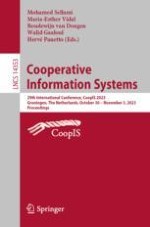2024 | Buch
Cooperative Information Systems
29th International Conference, CoopIS 2023, Groningen, The Netherlands, October 30–November 3, 2023, Proceedings
herausgegeben von: Mohamed Sellami, Maria-Esther Vidal, Boudewijn van Dongen, Walid Gaaloul, Hervé Panetto
Verlag: Springer Nature Switzerland
Buchreihe : Lecture Notes in Computer Science
